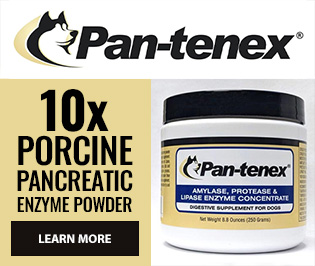Feeding a homemade diet can transform the health of a dog on digestive enzymes. For dogs that struggle with nutrient absorption, switching to a fresh, carefully balanced diet can reduce stool volume, improve weight gain, and boost energy. When paired with a potent porcine enzyme powder like Pan-tenex, a homemade diet gives your dog the best chance at proper digestion and long-term gut health. This guide covers everything you need to know, from recipe building to portion sizes for small, medium, and large dogs, as well as practical tips to make the process affordable and sustainable.
Why Homemade Diets Benefit Dogs on Digestive Enzymes
Dogs that need enzyme supplementation often have trouble breaking down proteins, fats, or carbohydrates on their own. A homemade diet gives you total control over ingredient quality, moisture levels, and fat content so enzymes can work as efficiently as possible. Many owners report dramatic improvement in stool consistency and weight maintenance after switching from a high-fiber commercial diet to a simple, enzyme-friendly homemade plan.
- Customizable ingredients: Avoid fillers, grains, and ingredients that irritate your dog’s gut.
- Better palatability: Many dogs eat more eagerly when meals are warm and freshly prepared.
- Improved absorption: Fresh food paired with Pan-tenex allows more calories and nutrients to be used rather than wasted.
- Reduced stool size: When food is better digested, there is less waste, which is a key indicator of improved nutrient use.
Essential Guidelines for Homemade Diets
- Protein first: Choose high-quality animal protein such as chicken, turkey, beef, or fish as the foundation of every meal.
- Moderate fat: Healthy fats like fish oil, chicken fat, or coconut oil can improve energy, but monitor stool consistency and adjust as needed.
- Very low fiber: High-fiber foods can interfere with enzyme function and increase stool volume. Stick to small amounts of cooked vegetables like green beans, carrots, or zucchini.
- Balanced calcium: Always add a calcium source such as ground eggshell or a veterinary-recommended calcium supplement when not feeding raw meaty bones.
- Consistency matters: Keep meals simple and repeatable to avoid irritating a sensitive digestive system.
Ingredient Substitution and Troubleshooting Guide
Use this table to help choose ingredients that work best for your dog’s digestion and to troubleshoot issues if stool quality changes after a diet adjustment:
| Ingredient Category | Recommended Options | Use with Caution | Tips |
|---|---|---|---|
| Proteins | Chicken, turkey, lean beef, pork loin, white fish, salmon, eggs | Fatty cuts of meat, lamb, duck (may loosen stool) | Rotate proteins every few weeks for variety. Cooked or raw can be used as long as enzymes are added properly. |
| Carbs | Sweet potato, pumpkin, oats | Legumes, peas, high-fiber grains | Stick to small portions. Too many carbs can increase stool volume. |
| Vegetables | Carrots, zucchini, spinach, green beans | Broccoli, cabbage, cauliflower (can cause gas) | Steam or puree vegetables for better digestibility. |
| Fats | Fish oil, coconut oil, chicken fat, olive oil | Butter, bacon fat, fried oils | Introduce fats gradually and monitor stool firmness. |
Transitioning to a Homemade Diet
Dogs on digestive enzymes may be sensitive to sudden food changes. Transition over 5–7 days by gradually replacing a portion of their old food with the new homemade diet while continuing to add Pan-tenex to each meal. Watch stool quality closely and adjust gradually until fully transitioned. For tips on enzyme preparation, see How to Mix Enzyme Powder with Your Dog’s Food.
Sample Meals for Different Dog Sizes
Small Dogs (Under 20 lbs)
- 1–2 ounces cooked ground turkey or chicken
- 1 tablespoon well-cooked brown rice
- 1 teaspoon pumpkin puree
- Calcium supplement or ground eggshell
Medium Dogs (20–50 lbs)
- 3–5 ounces lean beef, chicken, or fish
- ¼ cup cooked sweet potato or brown rice
- Small portion of steamed green beans or spinach
- 1 teaspoon coconut or salmon oil
Large Dogs (50+ lbs)
- 6–8 ounces lean meat or raw meaty bones (if feeding raw)
- ½ cup cooked brown rice or sweet potato
- Pureed carrots or zucchini
- 1–2 teaspoons fish oil or healthy fat source
Always mix in the recommended amount of Pan-tenex with moisturer, let sit for 15–20 minutes, and then serve.
Common Mistakes to Avoid
- Too much fiber: Avoid peas, lentils, and high-fiber vegetables as they can interfere with enzyme activity.
- Overcooking meats: Light cooking retains more nutrients and is easier on digestion.
- Feeding cold meals: Room temperature or slightly warm meals are more appealing and digestible.
- Skipping moisture: Always add water to activate enzymes properly, but do not create a soupy mess.
Budget-Friendly Tips
- Buy in bulk and portion meals ahead of time.
- Use seasonal vegetables and affordable protein sources.
- Cook in large batches once a week and freeze for convenience.
Case Study: Max the Mixed Breed
Max, a 35-lb rescue mix, struggled with four to five loose stools per day before starting Pan-tenex and switching to a turkey and brown rice diet. Within two weeks, his stools became smaller and firmer, and he gained six pounds of healthy weight. His owner uses the Dog Enzyme Digestive Health Stool Tracker weekly to monitor ongoing results.
Final Thoughts
A homemade diet paired with Pan-tenex offers dogs on digestive enzymes the best chance at proper nutrient absorption and long-term gut health. By choosing digestible ingredients, avoiding common mistakes, and staying consistent, you can help your dog feel better, gain or maintain weight, and enjoy life with more energy. For more information, see our other help articles or contact us for guidance.

